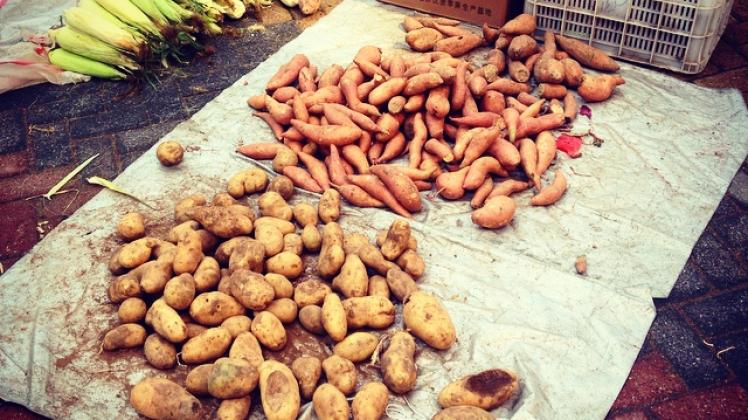China: China and the Sweet Potato
Today China is the world’s biggest producer of sweet potatoes but this staple of the Chinese diet was a relatively modern import to this ancient civilization.

For millennia the staple crops for China were wheat in the north and rice in the south but both are complex to cultivate and are quite labor and land intensive. The sweet potato would come along and change the course of Chinese history with its simplicity in cultivation and availability to China’s poorest.
The Colombian exchange
The sweet potato, a native of the west coast of South America, arrived in China via the Spanish Philippines. In fact almost all potatoes we have in the world today can be traced back to a single mountain range in present day Chile. Regardless, after the European colonization of the Americas after 1492, the whole world became involved in what is referred to as the ‘Colombian exchange’. This term describes the exchange of people, plants, animals, diseases, ideas, and culture that occurred as Europeans and Asians moved into the Americas and interacted with the ecosystem and civilizations already living there.
One of the most important exchanges that occurred was the introduction of the potato plant to these European and Asian civilizations. Not just in China but elsewhere the potato changed the histories of the so-called old world. Societies on the verge of extinction were saved by this new crop that could keep people fed cheaply. Why? Because the potato is the ultimate superfood; a human being can receive all their essential vitamins and minerals on a diet of just potatoes and milk. They are also easy and cheap to grow and for this reason potato became the staple food of otherwise poor or declining civilizations after the 16th century.
The potato arrives in China
The introduction of the sweet potato to China is in fact so recent that its origin story has survived and was as early as the 18th century written up into a Chinese essay that became popular.[1] The story goes that a Chinese merchant named Chen Zhenlong in the early 1590s came across the sweet potato (ipomoea batatas) in his contact with Spanish merchants in the Philippines. Bribing the Spanish, he took pieces of the vine home to his native China. Chen smuggled the vines by twisting them in ropes on his ship.
He was caught by Spanish customs who were trying to stop China getting their hands on any product that could give them a trade advantage. For whatever reason they let Chen through and he returned to China with his new favoured vegetable. Despite withering on the journey, once the vines made it to China they were stuck and thrown onto infertile ground where there flourished.
The potato changes China
While all this potato vine smuggling was going on, China itself was in the middle of a mini ice age that caused two decades of hard rains in the 1580s and 1590s. These rains flooded the great rice paddle fields of the southern regions of Fujian, Guangdong, and Sichuan. Famine spread as people lost everything. Chen Zhenlong’s son showed the crop his father had brought to China to the local governor of Fujian and persuaded him to let the people use it to grow a new food that could feed them cheaply and with no reliance on the complex irrigation systems of rice cultivation.
It worked. The crop spread quickly and fed the peoples of Fujian just in time for the fall of the Ming dynasty and the consequent wars and disruption that would plunge the country into chaos. The massive internal refugee crisis this period of Chinese history caused forced people onto new land that was not suitable for traditional food production. Known as shack people by other Chinese these refugees mainly of Hakka ethnicity found the soil was too thin for wheat and the slopes too steep for the irrigation of rice paddies.
Enter the sweet potato again to save the day. The Hakka people adopted American crops like potatoes, maize, and tobacco and thrived on China’s south-east coastline. Planting maize and potatoes into every piece of land they could, the shack people and migrants almost tripled the nation’s cultivated area between the years 1700 and 1850.
Soon many Chinese farmers’ diets revolved around the sweet potato, not just rice and grain: sweet potatoes baked and boiled, sweet potatoes ground into flour for noodles, sweet potatoes mashed with pickles or deep fried with honey or chopped into stew with turnips and soybean milk, even sweet potatoes fermented into a kind of wine.[2] When European missionaries arrived a century later, all they could find was potato crops in the region.
Potatoes then moved westward into the interior of the Qing empire through Sichuan and then into Tibet. Along the way they revolutionized agriculture wherever they went. Potatoes increased arable land and food stocks and therefore increased populations. Where once desperate poor people toiled for food day after day, now people could develop themselves and their cultures.
For almost two millennia, China’s population had grown very slowly but from the arrival of American crops including the sweet potato in particular, by the end of the eighteenth century, the population of China soared. Historians debate the exact size of the increase; many believe the population roughly doubled, to as much as 300 million people.
This population growth would have important consequences for the future of the Qing dynasty but the point is made that if it was not for that humble American crop the potato, China would look a lot different today than it might of if wheat and rice had remained as the staple foods of the Chinese diet. While not wholly responsible of course, the sweet potato did contribute significantly to the change of work, diet, and standard of living of China’s poorest which would latter have fatal consequences for the future of the Chinese imperial system in the twentieth century.
Fuente: http://www.chinastudyabroad.org/indepthchina/1039-china-and-the-sweet-potato









